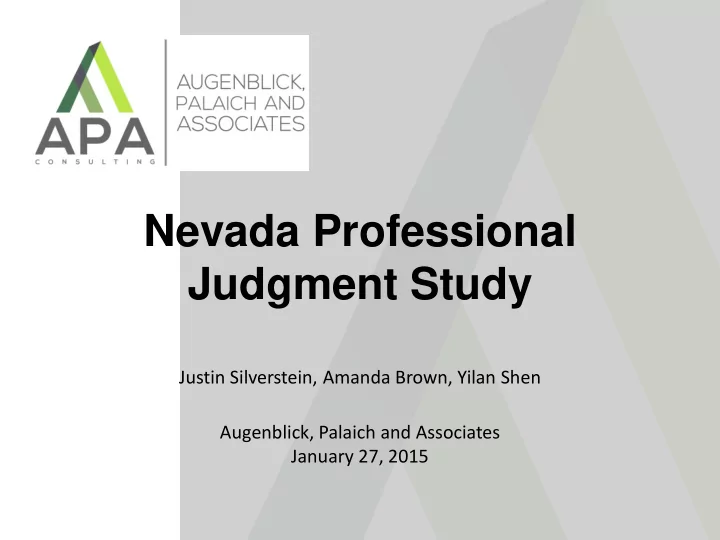

Nevada Professional Judgment Study Justin Silverstein, Amanda Brown, Yilan Shen Augenblick, Palaich and Associates January 27, 2015
Overview of Study • Professional judgment process to update 2006 Adequacy Study base cost and ELL weight – Considered three levels of ELL students (L1/L2, L3/L4, L5/Monitoring) • Review of additional weights (at-risk, special education) and adjustments (size, cost of living) from 2006 Study • Modeling Adequacy Costs in Nevada, comparing against actual expenditures (2012-13) 2
Professional Judgment Process • Professional Judgment (PJ) approach relies on the expertise of education professionals to identify the resources needed so all students can meet all state standards, as well as additional resources to serve identified need students – Average salary/benefits, technology prices applied to these figures to create base cost and weights • Convened 5 PJ panels in October 2014 – Elementary, Middle, and High school panels to examine base costs – ELL and System-wide panels • Spoke with a number of ELL experts to prepare for ELL panel – Panels included teachers, principals, ELL coordinators, technology specialists, district-level administrators, CFOs – Resources discussed included: personnel, non-personnel cost areas, additional programs and services, and technology – Panelists provided starting point figures from Evidence-based research (base education) and recommendations from interviews from national ELL experts 3
Professional Judgment Results • Key resources from Nevada PJ panels for all students (base): – Small class sizes: 15:1 for K-3rd grade, 25:1 for 4th-12th grade; – Professional development and instructional coaches for teachers; – Student support (counselors, social workers); – Technology rich learning environments, including one-to-one student devices and needed IT support; and – Preschool recommended for all four year olds. • Key resources from Nevada PJ panels for ELL students: – Multi-faceted approach to ELL education to ensure that the education of ELL students is the responsibility of everyone, including ELL teachers for direct instruction and/or co- teaching, instructional coaches to provide all teachers with guidance on ELL instruction, interventionists to work one-on-one with students, and pupil support through social workers and family liaisons, as well as counselors at the high school level. – A focus on addressing “long - term” ELL needs for students that often stay in the L3-L4 category; – Ongoing monitoring support for students that have transitioned out of the L1-L5; and – Before and after school, summer school for L1-L4 ELL students. 4
PJ Results- Base Cost • Detailed School-level Base Costs Elem. School Middle School High School School-level Costs, $7,690 $6,313 $6,225 Base Personnel Costs $7,005 $5,541 $5,093 Professional $223 $192 $188 Development Non-Personnel Costs $200 $300 $600 Technology $261 $264 $240 Other Programs $0 $17 $104 • Combined School-level Base Cost: $6,862 • District-level Cost: $1,715 5
PJ Results- ELL Costs and Weights • School-level ELL Costs Elementary School Middle School High School $3,482 $2,749 $3,021 ELL- L1, L2 $2,617 $2,749 $2,898 ELL- L3, L4 $1,063 $1,140 $768 ELL- L5, Monitoring • District-level ELL Costs: $350 • ELL Weights: ELL- L1, L2 0.41 ELL- L3, L4 0.36 ELL- L5, Monitoring 0.13 6
Determining Additional Adjustments and Weights • Needed to determine additional adjustments and weights for: • At-Risk • Special Education • District Size • Cost of Living-Location Cost Metric (LCM) • Reviewed 2006 Nevada study results and compared against adequacy studies nationally • CO, CT, KY, MN, MT, PA, SD, TN, and Washington D.C. • At-risk weight (.35) and special education weight (1.1) within national ranges, size adjustment also comparative – All determined to be appropriate for use • A cost of living adjustment is needed, but 2006 LCM likely does not reflect current economic realities, use cautiously 7
Base Cost, Weights, and Additional Adjustments for Modeling Statewide Adequacy Costs Base Cost, Size Adjusted Minimum $8,251 Weights ELL 0.42 At- Risk 0.35 Special Education 1.10 Additional Adjustments Size Less than 780 students Students X (-0.0008789)) +2.311 781 – 6,500 students (Students X (-0.0000868+1.6938 More than 6,500 students (Students X (-0.000002067)) +1.1429 No district would have a size factor below 1.0 LCM (Cost of Living) 83.2- 104.7 8
Total Cost of Adequacy in Nevada Districts, 2012-13 • Applying these weights and adjustments to the 17 non- charter school districts in Nevada produced the following total cost of adequacy figures for 2012-13: Size Adjusted Base $3,595,832,307 At-Risk $652,548,881 ELL $236,309,902 Special Education $448,834,516 Total -Without LCM $4,933,525,606 -With LCM $4,927,768,519 9
Total Cost of Adequacy Compared to Actual Expenditures in Nevada Districts, 2012-13 • Total adequacy costs, without LCM, were than compared against the 2012-13 expenditures-excluding capital, transportation and food service. – Figures presented do not include preschool. Current Expenditures Total Per Pupil $3,303,731,046 $7,809 Current Expenditures Adequacy, without LCM $4,933,525,606 $11,661 Difference $1,629,794,560 $3,852 10
Recommend
More recommend